According to the 16th census 2025 released by the Gujarat Forest Department, the Asiatic lion (Panthera leo persica) population in Gujarat will increase from 674 to 891 in 5 years.
What are the Key Findings of the 16th Asiatic Lion Census 2025?
- Total Population: 891 Asiatic lions recorded in Gujarat, a 32.2% increase from 674 lions in 2020 (15th census).
- Population Distribution: 384 lions live inside protected forest and sanctuary areas. Lions in non-forested areas have risen from 340 in 2020 to 507 in 2025.
- 44.22% of the lion population now resides outside traditional protected habitats.
- Gir National Park and adjoining sanctuaries (Gir Wildlife Sanctuary and Pania Wildlife Sanctuary) house 394 lions, which form the core population.
- Amreli district has the highest count of 257 lions, while Mityala Wildlife Sanctuary doubled its population to 32 lions.
- Barda Wildlife Sanctuary near Porbandar has become a newly established lion population area, with 17 lions recorded, the first since 1879.
- The 2025 census also identified new satellite populations around Jetpur and Babra-Jasdan.
- Adult Females: 330 adult females recorded, a 27% rise since 2020, indicating strong potential for further growth.
- Reasons for the Population Boom: Project Lion has helped in restoring habitats, strengthening the prey base, and mitigating conflicts to support Asiatic lion conservation.
- Census methodology: Conducted using direct beat verification (the area was divided into regions, zones, and sub-zones with designated officials, enumerators, supervisors, and volunteers), a more scientific and statistically robust method compared to pugmark-based tiger surveys.
- Completed in just three days, unlike the tiger census, which takes two years.
What is Project Lion?
- Project Lion: Announced in 2020, Project Lion is a long-term initiative aimed at securing the future of Asiatic lions by creating a sustainable environment that enhances the overall health of their ecosystems.
- The project, being implemented in the Gir landscape in Gujarat, focuses on habitat improvement, the use of advanced technologies such as radio-collaring and camera traps for monitoring, and the mitigation of human-wildlife conflict.
- The Gujarat Forest Department plays a central role in implementing these conservation measures, conducting regular lion censuses to track population trends and health.
- Technologies in Lion Conservation: Advanced tools such as Global Positioning System-based tracking are used to monitor lions and vehicles, ensuring efficient surveillance.
- An automated sensor grid, which includes magnetic, movement, and infrared heat sensors, helps detect and track wildlife activity.
- Geographic Information System (GIS)-based real-time monitoring enables timely analysis, report generation, and effective management of conservation efforts. source: dristiias.













Recent Comments
No comments yet.